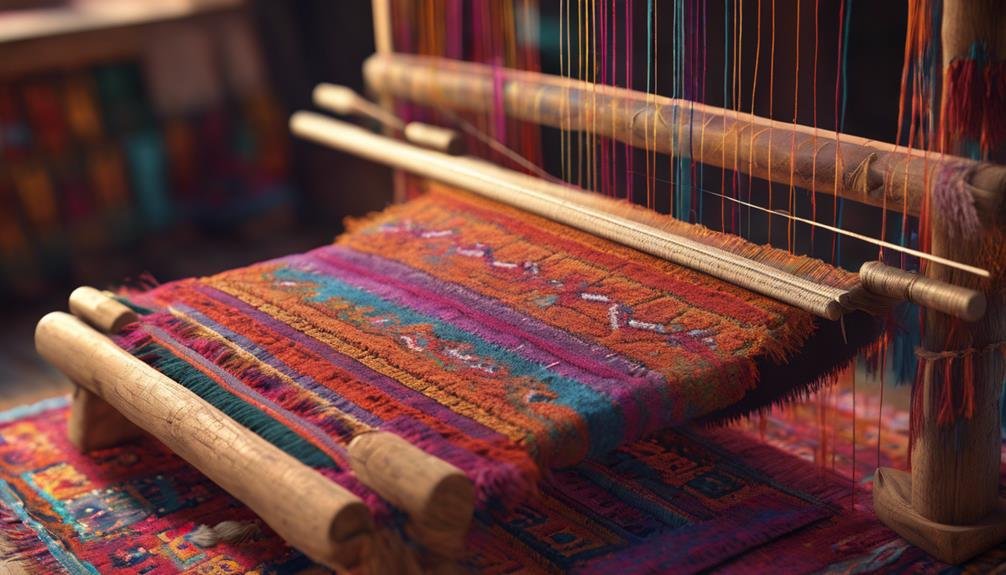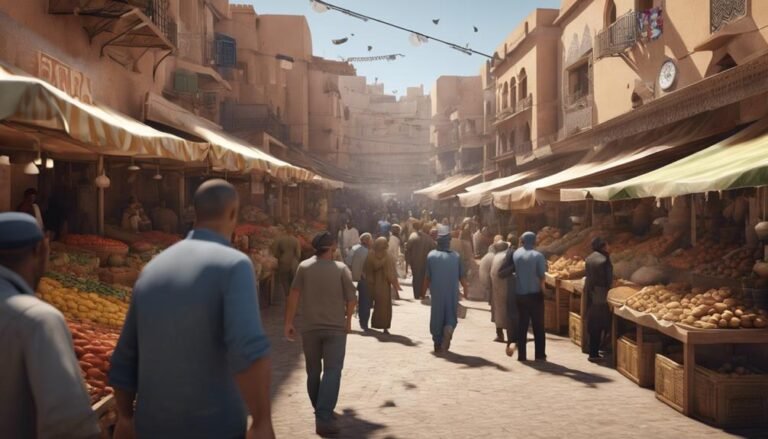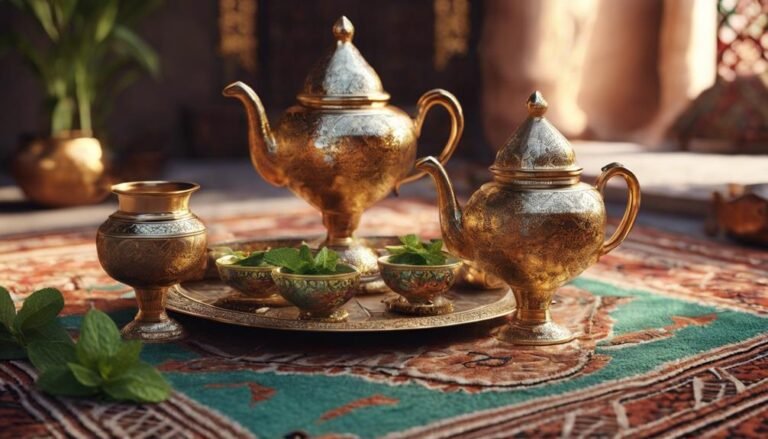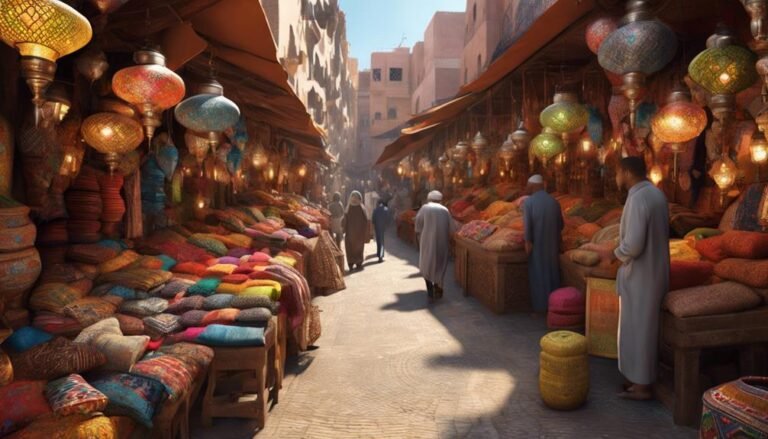Discover Berber culture, rooted in ancient North Africa and shaped by diverse influences like the Phoenicians, Romans, and Arabs. Experience a rich tapestry of traditions blending indigenous practices with external elements. Explore unique languages like Tamazight and Tachelhit, essential for cultural preservation. Engage in vibrant music, intricate textiles, and flavorful cuisine reflecting deep connections to land and heritage. Embrace nomadic practices, sustainable design, and festive celebrations integral to communal life. Unravel mythical folklore, showcasing mythical creatures and cultural values. Berber culture offers a fascinating journey into a world of resilience, adaptability, and rich heritage waiting to be explored further.
Key Takeaways
- Berber culture originates from ancient North Africa with diverse traditions and influences.
- It showcases linguistic diversity with languages like Tamazight and Tachelhit.
- Rich in music, dance, textiles, and culinary traditions reflecting deep cultural roots.
- Architecture integrates with nature, emphasizing sustainability and community design.
- Festivals, folklore, nomadic practices, and education play vital roles in preserving Berber heritage.
Origins of Berber Culture
The origins of Berber culture can be traced back to ancient North Africa, where the Berber people developed unique traditions and practices that have shaped their identity over centuries. Cultural influences from various civilizations, such as the Phoenicians, Romans, Vandals, Byzantines, and Arabs, have played a significant role in the evolution of Berber culture. These interactions have contributed to the diverse tapestry of Berber traditions, reflecting a blend of indigenous practices with external influences.
The historical significance of Berber culture lies in its resilience and ability to adapt to changing environments while preserving its core values. Through centuries of societal transformations, the Berber people have maintained a strong connection to their heritage, reinforcing a sense of identity and belonging. This steadfast commitment to their roots has solidified Berber culture as an integral part of North Africa's historical narrative, showcasing the endurance and richness of its traditions.
Language and Dialects
Exploring Berber culture reveals a diverse linguistic landscape encompassing various languages and dialects spoken by different Berber communities across North Africa. Berber languages are vital to the cultural preservation of the Berber people, reflecting their deep-rooted history and heritage. The linguistic diversity among Berber communities is striking, with Tamazight, Tachelhit, Kabyle, and Rifian being some of the prominent Berber languages spoken. Language evolution is evident in Berber culture, with each dialect carrying unique characteristics shaped by historical influences and interactions with other cultures over time.
Regional variations play a significant role in the Berber linguistic landscape, with distinct dialects emerging based on geographical locations and historical developments within specific communities. Despite these variations, efforts are being made to promote and preserve Berber languages, recognizing their importance in maintaining the cultural identity of Berber communities. Language isn't just a means of communication for the Berber people; it's a symbol of their rich cultural heritage and a reflection of their resilience in the face of external pressures.
Traditional Berber Music
Traditional Berber music is a rich tapestry woven from unique instruments, diverse influences, and distinctive melodies.
The instruments used, such as the bendir and the gimbri, contribute to the authentic sound of Berber music.
Influences from various cultures and historical events have shaped the vibrant and soulful characteristics of Berber melodies.
Instruments Used in Berber Music
Delving into the rich tapestry of Berber musical traditions reveals a diverse array of instruments that play an essential role in shaping the unique soundscapes of the culture. Traditional Berber music often features instruments like the bendir, a large frame drum, and the gasba, a type of flute, both of which hold deep cultural significance. These instruments aren't just tools for creating melodies but are also emblematic of Berber heritage and traditions.
While traditional melodies are still cherished and preserved, modern adaptations have seen the integration of new instruments like the guitar and keyboard into Berber music, reflecting a fusion of old and new influences. The blend of traditional instruments with modern adaptations adds a dynamic layer to Berber music, keeping the culture's musical heritage alive and evolving.
Influences on Berber Music
A myriad of influences intricately shape the essence of Traditional Berber Music, weaving together a tapestry of cultural heritage and historical significance. Berber music evolution is deeply rooted in Berber dance traditions, with rhythmic beats and melodies reflecting the vibrant energy of these dances.
Over time, Berber music has also experienced cultural fusion, incorporating elements from various civilizations that have interacted with the Berber people. Contemporary influences such as modern instruments and global music trends have further molded Berber music, creating a dynamic blend of traditional sounds with modern expressions.
This rich tapestry of influences has ensured that Berber music remains an essential and evolving art form that continues to captivate audiences worldwide.
Characteristics of Berber Melodies
Berber melodies exhibit a distinct rhythmic complexity that reflects the cultural tapestry of Berber music, intertwining historical influences with contemporary expressions.
Musical influences from various civilizations that have crossed paths with Berber communities throughout history can be heard in the intricate rhythms and melodies.
The cultural evolution of Berber musical traditions is evident in the way traditional Berber music has adapted to modern influences, creating a unique blend of sounds that resonates with both the past and the present.
This fusion of Berber musical heritage with contemporary elements showcases the resilience and adaptability of Berber music, illustrating how it continues to evolve while preserving its rich cultural roots.
Textiles and Weaving
Textiles and weaving play a significant role in the rich cultural heritage of the Berber people, showcasing intricate patterns and craftsmanship passed down through generations. Berber textiles are renowned for their vibrant colors, unique designs, and the skillful techniques used in their creation. Traditional Berber textile techniques include hand-weaving, embroidery, and natural dyeing processes, reflecting the deep connection the Berber people have with their land and environment.
The cultural significance of Berber textiles goes beyond their aesthetic appeal. They serve as a form of cultural expression, with each pattern and symbol holding a specific meaning or representing a particular tribe or region. Through textiles, Berber communities pass on their history, traditions, and values to future generations. Additionally, the art of weaving is often a communal activity, strengthening social bonds within the community.
Berber textiles not only serve as functional items such as clothing, blankets, and carpets but also as a form of art that embodies the identity and creativity of the Berber people.
Culinary Delights
When exploring Berber culinary delights, you'll encounter a rich tapestry of traditional dishes that reflect the region's vibrant culture.
The flavorful cuisine is characterized by the skillful use of culinary spices and herbs, adding depth and complexity to each dish.
From savory tagines to aromatic couscous, Berber cuisine offers a sensory experience that celebrates the land and its people.
Traditional Berber Dishes
With a rich culinary heritage deeply rooted in the North African region, Traditional Berber Dishes offer a delightful exploration of flavors and textures. Berber cuisine reflects a blend of cooking techniques and local ingredients, creating dishes that are both hearty and flavorful.
These traditional recipes hold immense cultural significance, often passed down through generations as cherished family recipes. The use of local ingredients such as couscous, dates, olives, and lamb showcases the connection between Berber culture and the land they inhabit.
Family recipes are a cornerstone of Berber culinary tradition, emphasizing the importance of sharing meals as a way to strengthen familial bonds and preserve cultural heritage.
Culinary Spices and Herbs
Exploring the vibrant world of Berber cuisine, Culinary Spices and Herbs play a pivotal role in enhancing the flavors of traditional dishes, adding depth and complexity to each culinary creation. Berber cuisine is known for its diverse and flavorful seasonings, which aren't only used for taste but also hold cultural significance within the community.
The use of spices and herbs varies across regions, with each area showcasing its unique cooking techniques and regional variations. From the fiery heat of cayenne pepper to the aromatic essence of cumin and coriander, Berber dishes are a symphony of flavors heightened by the careful selection and blending of these culinary treasures.
Embrace the rich tapestry of Berber culinary delights through the exploration of spices and herbs that define this unique gastronomic tradition.
Berber Architecture
Berber architecture showcases a blend of traditional techniques and unique design elements that reflect the rich cultural heritage of the Berber people. This architectural style is characterized by its sustainable design practices and commitment to cultural preservation.
Here are four key aspects of Berber architecture:
- Integration with Nature: Berber architecture is designed to harmonize with the natural environment, utilizing materials like mud, stone, and wood to blend seamlessly with the surrounding landscape.
- Functional Design: The layout of Berber buildings is purposeful, with each element serving a specific function. From the layout of courtyards to the positioning of windows for ideal ventilation, every aspect is carefully planned.
- Decorative Elements: Intricate geometric patterns, vibrant colors, and ornate carvings adorn many Berber structures, showcasing the skilled craftsmanship and attention to detail of the Berber artisans.
- Community Focus: Berber architecture often revolves around communal spaces such as courtyards and shared gathering areas, reflecting the importance of community and social interaction in Berber culture.
Festivals and Celebrations
Reflecting the vibrant cultural tapestry of the Berber people, Festivals and Celebrations serve as integral aspects of communal life and heritage preservation. Berber festivals are colorful and lively events that showcase the richness of Berber traditions. Cultural dances play a central role in these celebrations, with performers clad in elaborate traditional attire that varies from region to region, adding a visual feast to the festivities.
Religious practices are deeply intertwined with Berber festivals, often incorporating sacred rituals that have been passed down through generations. These rituals are a way for the community to honor their beliefs and connect with their ancestors. Each festival has its unique significance, whether it's to mark the changing of seasons, celebrate a bountiful harvest, or commemorate a historical event.
Attending a Berber festival offers a glimpse into the heart of Berber culture, where music, dance, and traditional clothing come together to create an immersive experience that celebrates the community's identity and heritage.
Berber Folklore and Mythology
Berber Folklore and Mythology are rich in mythical creatures, intriguing folklore stories, and enthralling legends that have been passed down through generations. These tales often intertwine with rituals and traditions, providing a glimpse into the cultural beliefs and practices of the Berber people.
From the mysterious Aisha Kandisha to the heroic Kahina, Berber folklore offers a fascinating insight into the spiritual and supernatural aspects of their culture.
Mythical Berber Creatures
Steeped in ancient traditions and beliefs, the folklore and mythology of the Berber culture are rich with a diverse array of mythical creatures. These creatures play a significant role in Berber legends and folklore, captivating the imagination of many. Here are four intriguing mythical Berber creatures:
- Abaasy: Known as cryptid creatures, these shadowy beings are said to lurk in the dark, preying on unsuspecting travelers.
- Ifrit: Folklore creatures like the Ifrit are powerful and malevolent spirits, capable of both good and evil deeds in Berber folklore.
- Agrit: These mythical beings are believed to dwell in rivers and springs, guarding the water sources and ensuring their purity.
- Ghouls: In Berber legends, ghouls are depicted as shape-shifting creatures that haunt graveyards and consume human flesh.
Folklore Stories and Legends
Within Berber folklore and mythology, tales of heroic feats and supernatural encounters weave a tapestry of cultural significance and intrigue. Berber folklore is rich with mythical beings and legends that have been passed down through generations.
These folklore tales often revolve around brave heroes, cunning tricksters, and powerful spirits. The stories aren't just entertainment but also serve to transmit cultural values and beliefs. Superstitions are also prevalent in Berber folklore, with many tales cautioning against certain actions or predicting future events based on signs and omens.
Through these folklore stories and legends, the Berber people connect with their past, preserve their traditions, and find meaning in the world around them.
Rituals and Traditions
With a blend of ancient customs and spiritual beliefs, the rituals and traditions in Berber folklore and mythology offer a glimpse into a vibrant cultural heritage.
- Cultural ceremonies, customs: Berber rituals often involve communal gatherings where traditional music, dance, and clothing play significant roles, reflecting the community's values and history.
- Generational practices, beliefs: Passed down through generations, Berber traditions like the Imilchil Marriage Festival showcase the importance of familial ties and communal celebration.
- Spiritual significance: Many Berber rituals have deep spiritual meanings, connecting individuals to their ancestors, nature, and the divine.
- Symbolism in traditions: Symbols like the Hand of Fatima are prevalent in Berber rituals, representing protection, blessings, and cultural identity.
Nomadic Lifestyle
Embracing a nomadic lifestyle, the Berber culture has historically thrived in the vast landscapes of North Africa. The Berbers are known for their adeptness at pastoral grazing, skillfully navigating the challenges of desert survival. Through centuries of experience, Berber nomads have developed intricate knowledge of the land, allowing them to sustain their communities by moving with their livestock in search of fertile grazing grounds and water sources. This lifestyle has shaped their cultural identity, emphasizing self-reliance, adaptability, and a deep connection to the natural environment.
—
| Pastoral Grazing | Desert Survival |
|---|---|
| Berbers excel at managing livestock such as goats and camels, utilizing the resources provided by their animals for sustenance. | The Berbers have mastered survival techniques in the harsh desert environment, including finding water sources, building temporary shelters, and navigating challenging terrains. |
Modern Influences and Preservation Efforts
Modern influences and preservation efforts have greatly impacted the traditional practices and cultural heritage of the Berber people in North Africa.
- Preservation Efforts: Various organizations and institutions are working to document and safeguard Berber languages, arts, and traditions to make sure they're passed down to future generations.
- Cultural Evolution: The Berber culture is adapting to modern influences such as globalization and technology, leading to a blend of traditional practices with contemporary lifestyles.
- Tourism Impact: The influx of tourists has both positive and negative effects on Berber communities, bringing economic opportunities but also influencing cultural authenticity.
- Education Initiatives: Efforts to incorporate Berber history and traditions into formal education systems are helping to raise awareness and preserve the cultural identity of the Berber people.
Conclusion
To sum up, Berber culture is a rich tapestry of traditions and customs that have been passed down through generations. From their unique language and dialects to their vibrant festivals and celebrations, the Berber people continue to preserve their heritage in the face of modern influences.
With a nomadic lifestyle rooted in folklore and mythology, they weave a colorful fabric of history that remains an integral part of their identity. Embracing both tradition and innovation, the Berber culture stands as a timeless oasis in a rapidly changing world.

The Editorial Team is a passionate group of Morocco enthusiasts dedicated to sharing the beauty, culture, and wonders of this captivating country. With diverse backgrounds and a deep love for travel, we strive to bring you engaging and informative content that inspires your Moroccan adventures. From uncovering hidden gems and sharing local insights to exploring mouthwatering cuisine and showcasing the vibrant lifestyle, our team is committed to providing you with valuable resources and exciting stories that enhance your exploration of Morocco. Join us on this journey as we celebrate the rich heritage and unforgettable experiences that make Morocco truly special.







